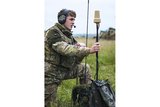Arctic SATCOM moves into the spotlight
The OneWeb gateway in Svalbard, Norway. (Photo: OneWeb/Kongsberg Satellite Services).
Historically, the Arctic has suffered from poor communications thanks partly to a lack of fixed infrastructure and hard-to-reach geostationary satellites positioned over the Equator.
However, emerging and groundbreaking technologies mean that Arctic nations (Canada, Denmark, Finland, Iceland, Norway, Russia, Sweden and the United States) can now consider alternative communication solutions to satisfy the requirement of armed forces operating across the region.
On 2 June 2021, for instance, OneWeb and Finnish state-run security network provider Erillisverko demonstrated low Earth orbit (LEO) satellite connectivity to Finnish government agencies, providing an example of how to support the operational requirements of multiple government agencies
Already have an account? Log in
Want to keep reading this article?
More from Space Solutions Special Report
-
![Delivering Space Solutions - the Crucial Layer for Missile Defence (video)]()
Delivering Space Solutions - the Crucial Layer for Missile Defence (video)
Against the backdrop of rising ‘peer’ and regional state rivals, the role of space-based assets for effective missile defence will be critical.
-
![Why space-based assets are crucial for effective missile defence (Studio)]()
Why space-based assets are crucial for effective missile defence (Studio)
Adding a space layer to missile defence is not an optional extra – it is crucial.
-
![British Army embraces SlingShot]()
British Army embraces SlingShot
Add-on kit turns UHF/VHF radio into a BLoS solution to support voice and data communications.
-
![Delivering Space Solutions - the New Digital Engineering Paradigm (video)]()
Delivering Space Solutions - the New Digital Engineering Paradigm (video)
Digital engineering is transforming the defence industry, from design to manufacturing.
-
![Digital engineering: a new era of manufacturing (Studio)]()
Digital engineering: a new era of manufacturing (Studio)
The digital engineering concept creates an environment where a single, digital source of truth empowers defence manufacturing.
-
![DEWC Systems takes MOESS sensor development to next stage]()
DEWC Systems takes MOESS sensor development to next stage
The MOESS programme intends to deploy a sovereign Australian tactical electromagnetic sensor capability, installed on a constellation of CubeSats. DEWC is developing a sensor that can conduct radar electronic support in defence-relevant radio frequency bands used by assets such as ships and aircraft.
























